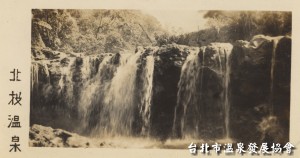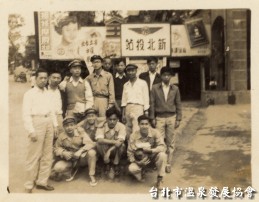|
|
|
|
●Brief History of Beitou The term of Beitou comes from “Pattsiran” (八芝蘭), which means ‘witch’ or ‘hot spring’ in the language of Ketagalan people (凱達格蘭族), one of Taiwanese Aborigines living around Taipei area at ancient times. In 17th centenary, almost all of the historic documents about Beitau told the stories about mining sulfur. In these stories, hot springs usually were described as a sort of toxic water. According to a document written by Dutch in 17th centenary, it was incredible hot in summer, and the air was stinking because of the sulfur in the area around midstream of Danshui River. Many Dutch soldiers died for the very bad climate and natural conditions. In 1717, A general named Ruan, Cai-Wen (阮蔡文) went to Beitau to inspect, and he was very impressed by the power of hot springs. He later wrote,”……in Beitau, the sulfur gas sprayed into sky, and the current of the hot springs was so strong that once fishes and shrimps touched the water of hot springs, they would die immediately.” In1918, in his famous book “General History of Taiwan”, Lian, Heng (連橫) wrote, “There are lots of sulfur in the area around Danshui River which is called Beitau today. During the time Spanish possessed Taiwan, they tried to mine the sulfur in Beitau. Since there were many miasmas, dangerous rivers, and baleful insects all over the area, the miners and laborers got ill frequently.” In 1896, Hirita Gengo (平田源吾), a Japanese businessman from Osaka, set up the first hot spring hotel, Tiangouan, in Beitau. It led Beitau into a totally new period that hot springs began to be commercialized. Following the steps of Hirita, Matsumoto Kametaro (松本龜太郎), the chief of Amy Finance Section, set up his own hot spring hotel too in the same year. Since then, the amount of hot spring hotels in Beitau grew rapidly like bamboo shoots after a spring rain. As well as hot spring baths, these new type hotels also offered sex services known for geishas and call-girls. The organizations for managing geishas were very active too. During Japanese colonization, Taiwanese people lived very hard. Only Japanese and rich Taiwanese businessmen could afford the luxurious enjoyment of hot spring hotels. While hot spring hotels were getting more and more in Beitau, most people in Taipei didn’t have any chance to go to the hotels in their whole life. For enjoying the fun of hot spring bath, many people started to seek for natural hot springs in the wilds. As the wild hot spring bathing became a new trend, there appeared many temporary outdoor bath pools in Beitau. In the November of 1905, Hasegawa Kinsuke (長谷川謹介), an advisor of the Taiwan Women Charity Association (TWCA), established the Bath Improving Association (BIA) with his friends to make efforts in building a better, cleaner and more sanitary public bath. It took them just less than one year to make it. The new public hot spring bath was opened in August, 1906. The construction contained 6, 000 feet pipes to provide clean and high quality hot spring water. Besides, BIA also bought many lands around the new public bath and built a big beautiful park there. In October of 1907, TWCA got the usage right of some Navy-owned lands where Longtang Bathhouse (瀧湯) was sited. BIA invested 1000 yens in repair the building and equipments of Longtang. After that, Longtang became a popular public bath, and many people volunteered to improve and beautify its surrounding. Since then, soaking in a public hot spring bath pool became trendy and gradually turned into an important symbol of Beitau culture. A good transportation system was a great contribution to the development of hot spring tourism in Beitau. During the 1900s, it was very hard to go to Longtang because it’s located on a hill. Walking along the muddy, circuitous, ups and downs trails, it usually took tourists several hours to get to Longtang or other hot spring hotels. For having more convenient traffic, many hotel owners petitioned for building new roads on the lands of Navy. Their needs got support from Murakami Shoichi (村上彰一), the Chief of Transportation Section, Railway Department. In March of 1907, Murakami Shoichi donated lots of wood and managed the work of new roads and bridges completed in one month. Unluckily, these new roads and bridges were destroyed several months later because of a huge rainfall. A substitute simple bridge was built later, but it was destroyed by rain too.  After the construction of new roads finished, Bachizhong Bus Company(巴汽中公司) began to run traffic services with two-way routes connecting Taipei city and Beitau district. Since the transportation was more convenient, it was attracting more tourists from other areas of Taiwan to visit Beitau for the enjoyment of hot spring bath. Among the countless tourists visiting Beitau, the Japanese Crown Prince Hirohito (裕仁) was the most famous one. For welcoming the Crown Prince Hirohito, Taipei Prefecture Government invested a lot of money in developing Beitau hot springs region. In 1913, the magistrate of Taipei Prefecture, Imura Daikichi (井村大吉), decided to spend 56,000 yens on improving and rebuilding Longtang Bathhouse and turned it into the Beitau Public Spring Bath. The design of the new bath was referred to the Mt. Izu Hot Spring Bath, the biggest and most famous hot spring bath in Japan then. A nature park was built nearby Beitau Public Spring Bath, and it immediately became the .biggest park in Taiwan. A new railway system connecting Beitau and Xinbeitau was built too. Since then, the trip to the Beitau Public Spring Bath was more convenient. The sources invested by the government brought Beitui a hugely radical change. In 1934, people erected a statue of Imura Daikichi in the Beitau Park in memory of his contribution to the Beitau hot springs business. While the government invested lots of sources in the hot spring business, many social organizations found their own role in Beitau. Since these organizations treated Beitau as an important leisure garden, they were willing to push Beitau forward by establishing entertainment centers, villas, and even temples. All these efforts made the culture of Beitau hot spring more outstanding and distinguishing. Generally speaking, hot springs business in Beitou was already highly developed distinguishingly during Japanese colonization. Both the hotels and public baths had good services and high quality hot spring water. The transportation was convenient. The ecological environment kept in a good condition because of the protection of law. For these various factors, Beitau kept its leading place in the Taiwan tourist industry for half centenary. Nowadays, Beitau is still one of the most popular options of hot springs tourism. Hot springs of witch in Beitau may always content overseas tourists with its amazing tender magic. |